Word When Something is Uniersal and Easy to Replace

-
Go to Home > Replace.
-
Enter the word or phrase you want to replace in Find what.
-
Enter your new text in Replace with.
-
Choose Replace All to change all occurrences of the word or phrase. Or, select Find Next until you find the one you want to update, and then choose Replace.
-
To specify only upper or lowercase in your search, select More > Match case. There are several other ways to search in this menu.
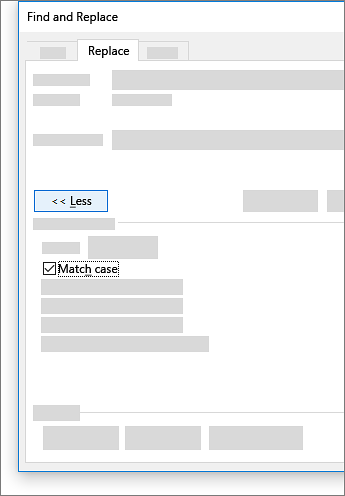
For other options, see Find and replace text
Find and replace basic text
In the upper-right corner of the document, in the search box  , type the word or phrase that you want to find, and Word will highlight all instances of the word or phrase throughout the document.
, type the word or phrase that you want to find, and Word will highlight all instances of the word or phrase throughout the document.
To replace found text:
-
Select the magnifying glass, and then select Replace.

-
In the Replace With box, type the replacement text.
-
Select Replace All or Replace.
Tips:
-
You can also open the basic Find and Replace pane with the keyboard shortcut CONTROL + H.
-
When you replace text, it's a good idea to select Replace instead of Replace All. That way you can review each item before replacing it.
-
You can find text with special formatting, such as bold or highlight, by using the Format menu.
-
Select View > Navigation Pane.

-
In the Navigation Pane, select the magnifying glass.
-
Select Settings
 , and then select Advanced Find & Replace.
, and then select Advanced Find & Replace.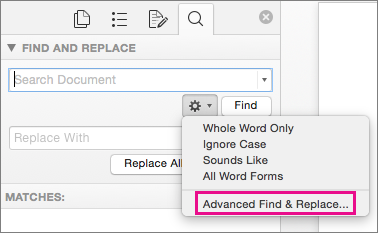
Notes:
-
Select the arrow at the bottom of the Find and Replace dialog box to show all options.
-
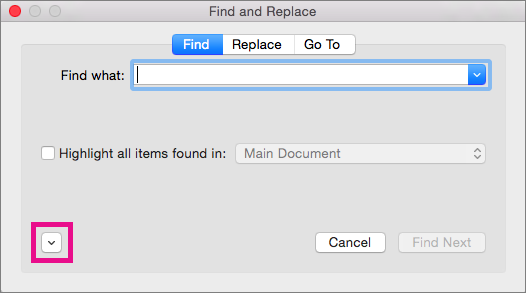
-
-
On the Format menu, select the option that you want.
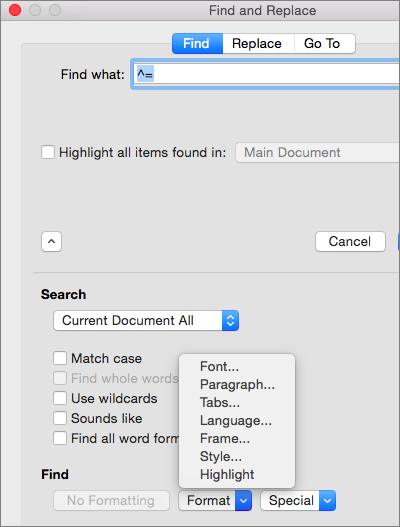
If a second dialog box opens, select the options that you want, and then select OK.
-
In the Find and Replace dialog box, select Find Next or Find All.
You can find and replace text with special formatting, such as bold or highlight, by using the Format menu.
-
Select View > Navigation Pane.

-
In the Navigation Pane, select the magnifying glass.
-
Select Settings
 , and then select Advanced Find & Replace.
, and then select Advanced Find & Replace.
-
At the top of the dialog box, select Replace.
Notes:
-
Select the arrow at the bottom of the Find and Replace dialog box to show all options.
-

-
-
On the Find what box, type the text that you want to find.
-
On the Format menu, select the formatting that you want to find.

If a second dialog box opens, select the options that you want, and then select OK.
-
Select in the box next to Replace with.
-
On the Format menu, select the replacement formatting. If a second dialog box appears, select the formats that you want, and then select OK.
-
Select Replace, Replace All, or Find Next.
-
Select View > Navigation Pane.
-
In the Navigation Pane, select the magnifying glass.
-
Select Settings
 , and then select Advanced Find & Replace.
, and then select Advanced Find & Replace.
Notes:
-
Select the arrow at the bottom of the Find and Replace dialog box to show all options.
-

-
-
On theSpecial menu, select the special character that you want to find.

-
Select Find Next.
-
Select View > Navigation Pane.

-
In the Navigation Pane, select the magnifying glass.
-
Select Settings
 , and then select Advanced Find & Replace.
, and then select Advanced Find & Replace.
Notes:
-
Select the arrow at the bottom of the Find and Replace dialog box to show all options.
-

-
-
At the top of the Find and Replace dialog box, select Replace and then select in the Find What box, but don't type anything there. Later, when you select a special character, Word will automatically put the character code in the box for you.
Note:Select the arrow at the bottom of the Find and Replace dialog box to show all options.

-
On theSpecial menu, select the special character that you want to find.
-
Select in the Replace with box.
-
On the Special menu, select the special character that you want to use as a replacement.
-
Select Replace or Find Next.
-
Select View > Navigation Pane.

-
In the Navigation Pane, select the magnifying glass.
-
Select Settings
 , and then select Advanced Find & Replace.
, and then select Advanced Find & Replace.
-
Select the Use wildcards check box.
If you don't see the Use wildcards check box, select
 .
. -
Select the Special menu, select a wildcard character, and then type any additional text in the Find what box.
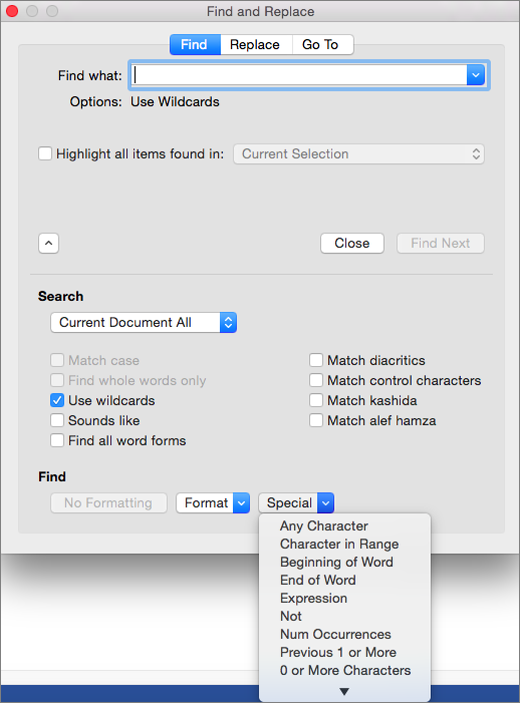
-
Select Find Next.
Tips:
-
To cancel a search in progress, press
 + PERIOD.
+ PERIOD. -
You can also enter a wildcard character directly in the Find what box instead of selecting an item from the Special pop-up menu.
-
To search for a character that's defined as a wildcard character, type a backslash (\) before the character. For example, type \? to find a question mark.
-
You can use parentheses to group the wildcard characters and text and to indicate the order of evaluation. For example, search for <(pre)*(ed)> to find "presorted" and "prevented."
-
You can search for an expression and use the \n wildcard character to replace the search string with the rearranged expression. For example, type (Newman) (Belinda) in the Find what box and \2 \1 in the Replace with box. Word will find "Newman Belinda" and replace it with "Belinda Newman."
-
-
To replace found text:
-
Select the Replace tab, and then select the Replace with box.
-
Select Special, select a wildcard character, and then type any additional text in the Replace with box.
-
Select Replace All, Replace, or Find Next.
Tip:When you replace text, it's a good idea to select Replace instead of Replace All. That way you can confirm each replacement to make sure that it's correct.
-
You can refine a search by using any of the following wildcard characters.
| To find | Use this | For example |
|---|---|---|
| Any single character | ? | s?t finds "sat" and "set." |
| Any string of characters | * | s*d finds "sad" and "started." |
| One of the specified characters | [ ] | w[io]n finds "win" and "won." |
| Any single character in this range | [-] | [r-t]ight finds "right" and "sight" and "tight." Ranges must be in ascending order. |
| Any single character except the characters inside the brackets | [!] | m[!a]st finds "mist" and "most" but not "mast." |
| Any single character except characters in the range inside the brackets | [!x-z] | t[!a-m]ck finds "tock" and "tuck" but not "tack" or "tick." Ranges must be in ascending order. |
| Exactly n occurrences of a character or expression | { n} | fe{2}d finds "feed" but not "fed." |
| At least n occurrences of a character or expression | { n,} | fe{1,}d finds "fed" and "feed." |
| A range of occurrences of a character or expression | { n, n} | 10{1,3} finds "10," "100," and "1000." |
| One or more occurrences of a character or expression | @ | lo@t finds "lot" and "loot." |
| The beginning of a word | < | <(inter) finds "interesting" and "intercept" but not "splintered." |
| The end of a word | > | (in)> finds "in" and "within," but not "interesting." |
Word for the web lets you find and replace basic text. You can match case or fine whole words only. For more varied options, open your document in Word for the desktop.
Source: https://support.microsoft.com/en-us/office/find-and-replace-text-c6728c16-469e-43cd-afe4-7708c6c779b7
0 Response to "Word When Something is Uniersal and Easy to Replace"
Post a Comment